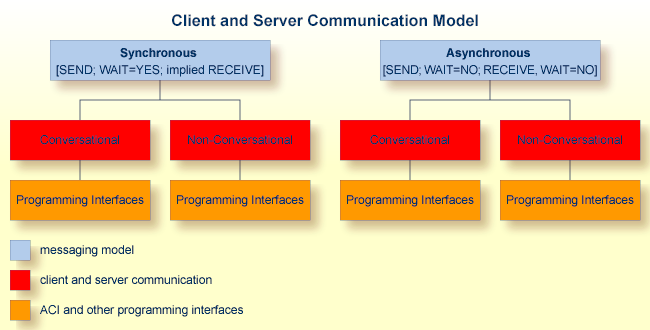This document covers the following topics:
Note:
After viewing this document, see the document
Common Use Cases, which supplies specific business examples of the
interoperability available through EntireX Broker.
This section introduces the basic concept of EntireX Broker: achieving highly flexible interoperability of application components in a distributed processing environment. This concept is described from the perspectives of
a messaging model
communication models
application programming interfaces
EntireX components
in order to give you a comprehensive, high-level view of how EntireX Broker enables flexible interoperability between distributed application components.
Note:
Unless otherwise indicated, the communication model used in this section is client and server, and
not publish and subscribe.
In a distributed processing environment that uses EntireX Broker,
communication occurs through application components exchanging messages. An
application component offering a service registers
it with EntireX Broker (see REGISTER); this makes the service available to other application
components able to communicate with EntireX Broker. An application component
intending to access a service issues its request through EntireX Broker, which
then routes the request to the specific application component offering the
service.
The following concepts help describe how message exchange is structured in EntireX Broker:
Synchronicity
The application initiating the request either waits for the result
to return, whereby it suspends all processing (synchronous); or it does not
wait for the result to return, whereby it is freed to do other processing
(asynchronous).
Conversationality
The request can either be a single pair of messages comprising
request/reply (non-conversational); or it can be a sequence of multiple
messages which are all part of the same request (conversational).
The following diagram shows the two major concepts of EntireX Broker's messaging model: synchronicity and conversationality. See ACI Syntax of Messaging Model below for a description of the messaging syntax.

The table below describes the messaging terms mentioned in the diagram above from the viewpoint of the application component initiating the request, as expressed in ACI syntax.
The ACI (Advanced Communication Interface) is the lowest level application programming interface that interacts with EntireX Broker. The ACI is common to all of the messaging models and communication models (see Communication Models and Interoperability) of EntireX.
| Messaging Term | Client and Server | Publish and Subscribe | |||
|---|---|---|---|---|---|
| Client | Server | Publish | Subscribe | ||
|
|
Synchronous | not applicable | not applicable | ||
| Asynchronous (3) | |||||
|
|
Conversational (3) | not applicable | not applicable | ||
| Non-conversational (3) | |||||
Notes:
SEND, WAIT=YES command contains an implied RECEIVE command.
WAIT=YES. RECEIVE_PUBLICATION. The advantage is that the program runs continuously, processing publications arising as random events, which simplifies
programming effort.
The EntireX Broker uses two communication models: client and server and publish and subscribe. Client-and-server communication is used if data is to be exchanged with exactly one partner; publish-and-subscribe communication is used if data is to be published. The ACI can be used for both client and server and publish and subscribe.
Client and Server
This model is based on the connection between exactly two partners:
client and server. This model covers the requirements of conversational
communication and asynchronous processing.
Publish and Subscribe
This model is implemented as an independent subsystem in the Broker,
that is, an attribute determines whether it is set to active or inactive.
The following diagrams shows the two types of communication model used in EntireX Broker: client and server and publish and subscribe.


Publish and subscribe is normally classified as an asynchronous communication model. It is non-conversational in terms of message flow, that is, publications between publisher(s) and subscriber(s). The classification "asynchronous" is chosen because neither publisher nor subscriber directly depends on the activities of the other. The publisher always sends publications in a non-blocked manner.
Note:
The subscriber has the option of specifying WAIT=YES
(see legend in above graphic). Example: The subscriber uses a repeat loop that
issues a
RECEIVE
PUBLICATION. The advantage is that the program runs
continuously, processing publications arising as random events, which
simplifies programming effort.